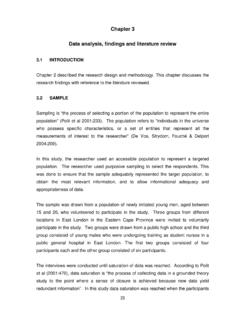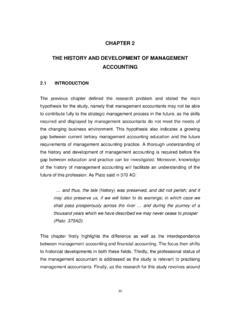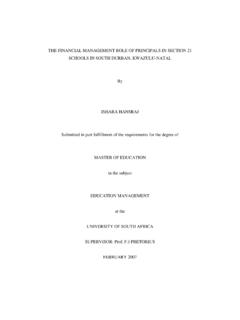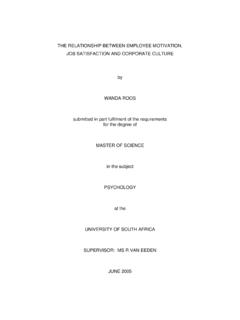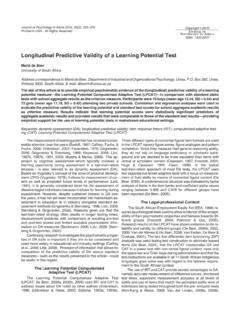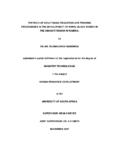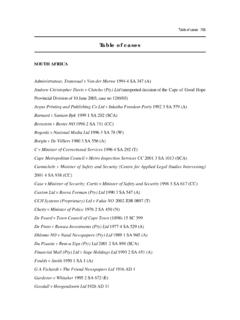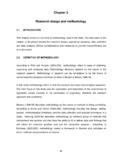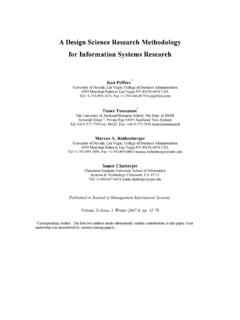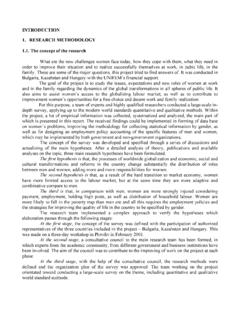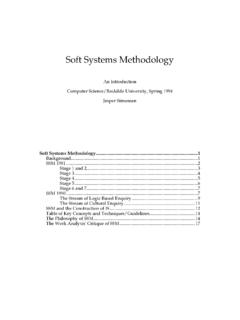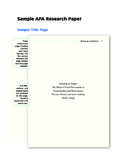Transcription of CHAPTER 1 Introduction and research methodology
1 1 CHAPTER 1 introduction and research is one of the most serious problems South Africa faces today. It puts a strain on thepublic, the business community, the economy and the government. Shop theft is a specifictype of theft that is a cause for serious concern, and compels criminologists to conductresearch regarding this main focus of this research will be on the South African shop theft situation, as itmanifests in a township environment. It specifically examines shop theft perpetrators interms of age, gender and scholastic details, with emphasis on the extent of young people=sinvolvement. The nature of shop theft as a criminal offence is also analysed from acriminological point of view. Furthermore, this CHAPTER deals with the basic notionsregarding the theory of research methodology , and describes the practical execution of theresearch as it was conducted for this (1991:203) mentions that research , as a scientific enterprise, is carried out with aparticular consideration in mind - the discovering of new facts regarding a specificphenomenon.
2 These facts are then used to describe and measure human behaviour in aparticular social environment. In order to acquire these intended research goals, it isimperative that the research findings should be accurate, and possess a precision that isstatistically order to comply with such standards, this CHAPTER will now focus on an explanation of themethodology used. The content focuses on aspects such as the research design, the aimof the research study, definitions of key terms and the method and procedures of datacollection. The scope of the study, in terms of universum, number of participating schools,and the duration of the study will also be discussed. The rationale behind the use of a2random sample, the survey questionnaire and the number of completed questionnaires willbe examined. Other factors such as ethical issues and the pilot study will be reviewed.
3 Challenges encountered during the research , such as the accuracy of detail, poorinstructions, and defects in the formulation of the questionnaire will be addressed, andoverall remarks will be made. Finally, there will be a brief outline of the presentation of theresearch main purpose of this CHAPTER is to highlight the problem statement, and discuss theresearch steps, procedures and processes undertaken in this research study. The aimsand hypotheses of the study will also receive attention. Permission to conduct such astudy, as well as the data capturing and statistical analysis of the data will be clarified. Thedefinition of the conceptual delimitation, as well as access and ethical issues, will also of the problemShop theft - as a universal criminological problem - is a serious economic problem, witha negative effect on company profitability. Most crimes in South Africa, including shoptheft, have increased over the past few years.
4 Shop theft is not only a South Africanproblem, but it is a global concern. The problem continues to grow and, as Farrell andFerrara (1985:2) argued, some time ago, shop theft remains to be a problem formerchants. The emergence of self-service created more opportunities for thefts to the SAPS Crime Information Analysis Centre (1999) the ratio of shop theftper 100 000 of the population for the years 1994 to 1999 appears to have remained fairlystable since 1995; that is, in terms of incidents reported to the South African 1: Shop theft per 100 000 of the population, 1994 to five percent decrease in 1998 should not be viewed as a real decline, but rather as adecline in the number of incidents reported to the Central Statistical Service report (now Statistics SA) of 1998 showed that a total of27 978 shop theft cases were prosecuted during the period of 1995/96; 4 867 of thesecases comprised young adults (aged 18-20) and 3 366 juveniles (aged 7-17).
5 Buckle and Farrington (Barlow 1990:251) conducted a study during 1984 in Englandregarding the number of shop theft incidents that occurred at one shop in a week. Theyfound that the incidents in that shop were ten times higher than the number of incidentsreported by the police, in the entire city and its surrounding areas. Other research findingsalso indicate that only about 10 percent of incidents involving shop theft are usuallydetected by staff members, which explains why there is such a significant difference inshop theft reporting between various (2000:446) accurately illustrates that the goals (aims) of literary research are todemonstrate familiarity, link the new research with prior research , synthesise the results,and finally, to learn and stimulate, as well as assist with the design of a measuringinstrument. This type of information is used and integrated with empirical research , inorder to describe, explain, prevent, control or predict a criminal on these statements, the aims of this research are to describe, analyse and explain(where applicable) young people=s views regarding the following.
6 4*what, according to their views, constitute crime,*the seriousness of shop theft in relation to other types of property crimes such asburglary and other types of thefts,*what constitutes shop theft, with a specific focus on the value of the merchandiseand the type of goods taken from stores,*the reasons for shop theft, with emphasis on opportunity, peer pressure, andrationalisation,*the appropriate punishment for shop theft in relation to the theft of similarmerchandise from the homes of the respondents and*the respondents views regarding their involvement in shop theft and their motivationfor the researcher will then endeavour to describe:*the profiles of the victims and offenders involved in shop theft,*the nature and extent of shop theft,*applicable aspects of policing, court procedures and punishments relating to shoptheft,*and explain the involvement of juveniles in shop theft with reference to some aspectsof different crime explanation researcher will also attempt to suggest an appropriate shop theft preventionprogramme based on the research aims, as well as the findings based on the literary research , directed thedevelopment of the HypothesesDixon et al.
7 (1987:39) regards a hypothesis as a statement that asserts a relationshipbetween variables. It is also regarded as a provisional answer to the question that theinvestigator intends to answer through the research mechanisms. A statement regardingsomething that ought to be observed in the real world, if the theory is correct, can also beviewed as a hypothesis. It can furthermore be defined as an expectation, with referenceto the nature of things extracted from a theory. They can be formulated negatively (nil-hypothesis) as opposed to the alternative hypothesis, which is constructed positively. The tests of statistical significance for this research was set at the 95 percent level (prob. 0,05)and 1 HoThe gender of the learners will influence their perceptions on shop gender of the learners will not influence their perceptions on shop 26 HoThe age of the learners will influence their perceptions on shop age of the learners will not influence their perceptions on shop 3 HoThe grade of the learners will influence their perceptions on shop grade of the learners will not influence their perceptions on shop 4 HoShop theft is caused by opportunistic theft is not caused by opportunistic 5 HoShop theft is caused by inadequate theft is not caused by inadequate 6 HoShop theft is caused by friends daring each other to do theft is not caused by friends daring each other to do attain the goals for the research and to test the hypotheses, a particular researchprocedure was procedures and processIn the first place.
8 Literary research was conducted. The literary research was utilised toconstruct the measuring instrument. Subsequently, a pilot study was conducted to finalisethe questionnaire. The empirical data was captured, statistically manipulated andintegrated with the literary to conduct the researchNeuman (2000:352) refers to a gatekeeper as someone with the formal or informalauthority to control access to a site. As far as this research undertaking is concerned, thenotion refers to school principals or headmasters of the selected institutions where thestudy was to be conducted. Some of the aspects the researcher took into account were:*The researcher made telephonic contact with the gatekeepers with regards to theintended research visits.*Personal visits by the researcher followed each of the selected schools, in order tomake preliminary arrangements with the gatekeepers.
9 *In the absence of the concerned gatekeepers, the deputy or a senior staff memberwas delimitationRegarding the geographical delimitation, the research was limited to the Mabopane , the area is situated approximately 35 kilometres north of Pretoria. It is anAfrican township situated in the North West Province. Two high schools were selected forthe survey, located not further than 5 kilometres data collectionThe following procedure was implemented with regards to data collection: The researcherrequested and was granted permission by the principals of the selected high schools todistribute and administer the completion of the questionnaires at a suitable time withoutinterfering with the learners= daily academic activities. During the empirical data capturing process the following instructions were provided to thelearners:*this is not a test, but a questionnaire about young people=s views pertaining to shoptheft,*there are no right or wrong answers,*your answer is the right answer for you,*mark the appropriate box using a tick,*please read every question and statement carefully before the measuring instrumentBabbie (2001:148) maintains that Rensis Likert has largely formalised the approach usedin this research project, through the development of the Likert scale (a model in whichresearch respondents are asked to strongly agree, agree, strongly disagree or disagree)as used in the final questionnaire pattern for this study.
10 Both questions and statements areemployed in the questionnaire. The use of both in the measuring instrument allows the9investigator more flexibility when items are constructed, and makes the method ofinformation gathering measuring instrument is used to record the questions and the answers. Thismeasuring instrument is formulated to satisfy the requirements of the research project, ofwhich it is an imperative was given to the nature and types of questions asked, as well as the wording,phrases and logical sequence of the questions. This made provision for the recording ofresponses and the division of directives to the respondents and therefore ensured thesufficient registration of the ensure uniformity, questionnaires had to be taken down orally - which yielded betterresults in terms of the purposes of this study. All instructions were communicated verballyand appeared in the questionnaire in order to ensure clarity and avoid ambiguity.
